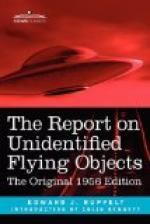The first hysterical report of the flurry came from the Air Defense Command. On September 23, 1951, at seven fifty-five in the morning, two F-86’s on an early patrol were approaching Long Beach, California, coming in on the west leg of the Long Beach Radio range. All of a sudden the flight leader called his ground controller—high at twelve o’clock he and his wing man saw an object. It was in a gradual turn to its left, and it wasn’t another airplane. The ground controller checked his radars but they had nothing, so the ground controller called the leader of the F-86’s back and told him to go after the object and try to identify it. The two airplanes started to climb.
By this time the UFO had crossed over them but it was still in a turn and was coming back. Several times they tried to intercept, but they could never climb up to it. Once in a while, when they’d appear to be getting close, the UFO would lazily move out of range by climbing slightly. All the time it kept orbiting to the left in a big, wide circle. After about ten minutes the flight leader told the ground controller, who had been getting a running account of the unsuccessful intercept, that their fuel was low and that they’d have to break off soon. They’d gotten a fairly good look at the UFO, the flight leader told the ground controller, and it appeared to be a silver airplane with highly swept-back wings. The controller acknowledged the message and said that he was scrambling all his alert airplanes from George AFB. Could the two F-86’s stay in the area a few more minutes? They stayed and in a few minutes four more F-86’s arrived. They saw the UFO immediately and took over.
The two F-86’s with nearly dry tanks went back to George AFB.
For thirty more minutes the newly arrived F-86’s worked in pairs trying to get up to the UFO’s altitude, which they estimated to be 55,000 feet, but they couldn’t make it. All the time the UFO kept slowly circling and speeding up only when the F-86’s seemed to get too close. Then they began to run out of fuel and asked for permission to break off the intercept.
By this time one remaining F-86 had been alerted and was airborne toward Long Beach. He passed the four homeward-bound F-86’s as he was going in, but by the time he arrived over Long Beach the UFO was gone.
All the pilots except one reported a “silver airplane with highly swept-back wings.” One pilot said the UFO looked round and silver to him.
The report ended with a comment by the local intelligence officer. He’d called Edwards AFB, the big Air Force test base north of Los Angeles, but they had nothing in the air. The officer concluded that the UFO was no airplane. In 1951 nothing we had would fly higher than the F-86.
This was a good report and I decided to dig in. First I had some more questions I wanted to ask the pilots. I was just in the process of formulating this set of questions when three better reports came in. They automatically got a higher priority than the Long Beach Incident.




